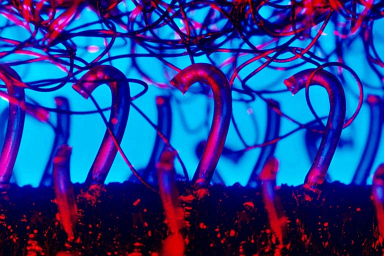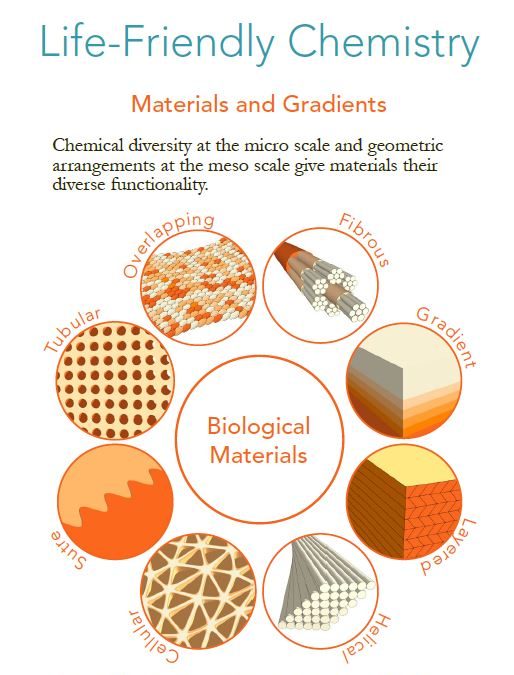Material Transitions: Towards Life-Friendly Chemistry
By Kira Hunt
Date
June 25, 2019
Velcro hooks mimic the burrs found on burdock plants. Image by Natural Philo via Wikimedia Commons.
Biomimicry is an ancient method with a shiny new name: it is the science, practice and philosophy of applying strategies found in nature to solve human design challenges. There are a number of successful examples of biomimicry today, including: Velcro, whose reusable fastener hooks mimic the burrs of the burdock plant; Interface carpet tiles which are inspired by various forest ecosystem elements, and WhalePower wind turbines that are more efficient by emulating the unconventional shape of humpback whale flippers.
This is just the beginning of what people can learn from nature. Can you imagine: high-quality products that self-assemble from locally-abundant resources, and then break down into non-toxic reusable components? This is what organisms and ecosystems do, but how they do this remains a mystery we have yet to uncover.
Packaging is one example that clearly showcases the differences between man-made and natural materials. Packaging is often comprised of uniform material layers: one type of material provides shape or strength and a second material is used to retain heat or provide waterproofing.
Life Friendly Chemistry

Click here to view larger image. Image from Functional gradients and heterogeneities in biological materials: Design principles, functions, and bioinspired applications. Liu, Z., Meyers, M. A., Zhang, Z., & Ritchie, R. O. (2017).
Biomimicry practitioners like to call chemistry in nature “life-friendly” because natural processes tend to enhance living systems rather than harming them. Many materials in nature are composed of gradients rather than abrupt changes. These materials transition slowly by making small incremental changes to density, fiber orientation, or other properties. The hard outer shell of a walnut, for example, is composed of long, tightly interwoven fibers that create an extremely tough protective layer. As you move toward the centre of the nut, these long fibers become incrementally less dense and hold bigger air pockets that provide insulation from heat and cold. Transitions such as these are prevalent in nature and create complex microstructures that provide multi-functionality.
Several materials in nature have desirable features that man-made materials do not, though they tend to use safer and more abundant elements like hydrogen, carbon, nitrogen and oxygen. Nature is able to form dynamic multi-functional materials by assembling elements in specific ways, resulting, for instance, in a material that combines strength (the maximum stress required before a material cracks or deforms) and toughness (the energy required to fracture a material that has a crack) to form a powerful and protective material, a feat that few man-made materials can match.
This is only one example of what we can learn from the natural world. If we can decode and emulate other processes like self-assembly and the use of water-based chemistry, the implications will be even more astounding.
Mother Nature’s Mystery
If we can learn to replicate Mother Nature’s extraordinary techniques, we would undoubtedly benefit from the new mechanical and physical properties they provide. 3D printing and other additive manufacturing technologies have opened the door for new methods that allow us to assemble and organize material structures at a tiny scale, and these methods provide insights into new manufacturing paradigms.
But just what can we learn from nature’s life-friendly chemistry – and how might we use this knowledge to improve our materials and manufacturing processes? I guess for me it comes down to layers: tiny patterns scale up to create the properties of the large-scale. For scientists, the links are more clear, but nature can offer metaphorical lessons for non-scientists too. Can these lessons offer direction for how to build life-friendly cities and societies? Can they show us how to develop environments that nurture future generations and enhance the natural world? The answers might just be found in the world around us.
Special thanks to Mark Dorfman and Tim Ward, instructors at the Life-Friendly Chemistry workshop, March 2019. Click here to learn more about the event.
For a technical paper to learn more about the properties of natural materials, check out: Liu, Z., Meyers, M. A., Zhang, Z., & Ritchie, R. O. (2017). Functional gradients and heterogeneities in biological materials: Design principles, functions, and bioinspired applications.
Kira Hunt is a Landscape Architectural Technologist at IBI Group. She has worked with a number of volunteer groups in Edmonton, including Biomimicry Alberta and Prairie Urban Farm and the Edmonton Public Art Committee.







